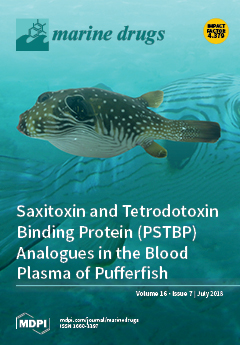Four new structurally related metabolites, one γ-lactone named gliomasolide F (
1), one δ-lactone named gliomasolide G (
2), and two medium-chain fatty acids named gliomacids A–B (
3–
4), each containing nine carbons in total, were identified from
[...] Read more.
Four new structurally related metabolites, one γ-lactone named gliomasolide F (
1), one δ-lactone named gliomasolide G (
2), and two medium-chain fatty acids named gliomacids A–B (
3–
4), each containing nine carbons in total, were identified from the sponge-associated fungus
Gliomastix sp. ZSDS1-F7-2. The planar chemical structures of these novel C9 metabolites were elucidated by nuclear magnetic resonance (NMR) spectroscopic methods, in connection with the analysis of high-resolution mass spectrometry (HRMS) and infrared (IR) data. The absolute configuration of
1, was determined by comparisons of experimental circular dichroism (CD) and optical rotation (OR) value with corresponding ones computed by quantum chemistry. The relative configuration of
2 was determined by the Nuclear Overhauser effect spectroscopy (NOESY) spectrum, while its absolute configuration was tentatively determined in view of the biogenetic and biosynthetic relationships between
1 and
2. Compounds
3–
4, originally as an inseparable mixture, were successfully isolated after chemical modifications. The stereo-chemistries of compounds
3–
4 were assumed by comparison of
13C NMR with those of the similar moiety reported in literature, in addition to the biogenetic and biosynthetic relationships with
1. The plausible biosynthetic relationships among these four C9 metabolites were supposed. Biologically, compounds
1–
4 showed no cytotoxic effect against HeLa cell line at concentrations up to 25 μg/mL, while
1 exhibited moderate antifouling activity against the settlement of
Balanus amphitrite larvae with IC
50 being 12.8 μg/mL and LC
50 > 25 μg/mL. The co-occurrence of macrolides gliomasolides A—E and four C9 metabolites in the same fermentation culture made us assume that these C9 metabolites might be biosynthetic building blocks toward the construction of more complex macrolides such as gliomasolides A—E or other unidentified polyketides.
Full article






